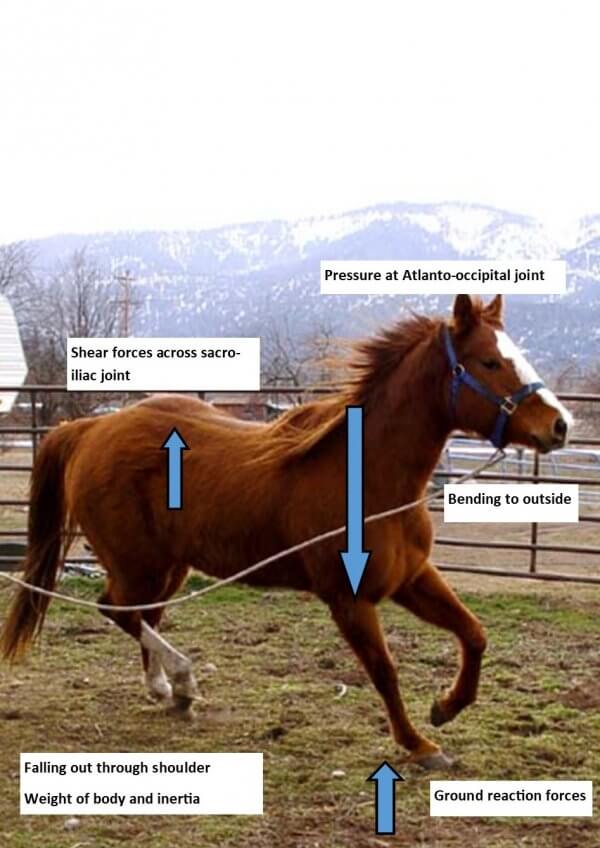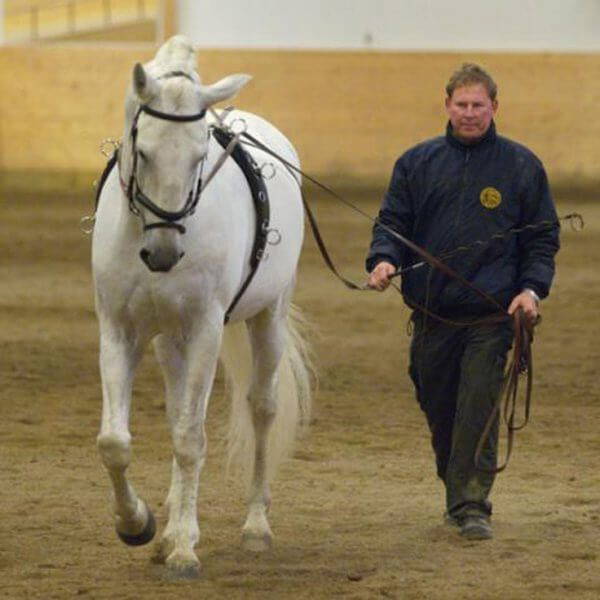Working our horses from the ground is an essential part of a horse’s education and training irrespective of his stage of life or ability. The benefits are many;
- Improved balance and rhythm
- Facilitation of the correct posture and outline and consequently strengthening of important postural muscles
- Provides him with an opportunity to work freely without the weight of saddle and rider
- Is an effective rehabilitation tool following an injury
- Provides the rider with an opportunity to observe his movement and gait
- Encourages communication and a good relationship between horse and handler
We often get asked the difference between lunging a horse and long reining and which is better. In most cases long reining over lunging would always be advocated.
 Why? The forces applied when the horse is lunged repetitively on a circle can result in;
Why? The forces applied when the horse is lunged repetitively on a circle can result in;
-Increased strain and rotational forces through the inside limb (which increases with speed)
-Increased compressive force on the inside limb
-Shear forces can travel higher up the limb and exacerbate or cause discomfort at the lumbo-sacral and sacro-iliac joint
-Horses are ‘into-pressure’ animals so as the long line puts pressure on the nose via the cavasson the horse will pull away from it increasing pressure at the atlanto-occipital joint (Poll).
-Less control from the handler to correct movement dysfunction i.e. falling through shoulder, lack of bend etc.
Basic tips for long-reining.
- Seek help from someone experienced in long-reining if you and your horse are new to the technique.
- The most common method is to attach the long reins to the bit then through the rings either side of a roller.
- The handler should be positioned at a safe distance behind the horse (although not directly behind him in his blind spot) with the outside rein coming around the horse’s quarters.
- With a nervous or inexperienced horse, you or an assistant can walk closer to the head then gradually step back as he improves in confidence.
- Incorporate transitions in to your work; walk-halt, walk-rein back, walk-trot etc.
 Remember to praise and reward often.
Remember to praise and reward often.- Ground poles can also be incorporated to encourage limb flexion, spinal flexibility, improved posture and activation of core muscles.
- Circles can be incorporated to encourage stretching through the outside of the body and improve flexibility.
Bradfords Veterinary Physiotherapists are well equipped to help guide you in all aspects of your horse’s musculoskeletal health. We pay great attention to detail ensuring that nothing is missed, in this way you ensure the health and wellbeing of your horse and safe guard his health of the future.
Please call 01432890490 or email info@bradfordsvetphysio.co.uk to book.
Search
Recent Articles
- How to take a horse from SHOES to BAREFOOT with Alex Ridgeway & Dr Mark Caldwell
- 8 Laminitis Myths Busted!
- I’ve learnt as I’ve got older to really listen to what the people around me say about others
- The dangers of sleep deprivation in horses
- The third part of our series on stretching and flexibility with Sharon Stuart or Stuart Equine – forelimb and neck stretches for the horse and shoulder stretches for the rider
Categories
- Advice Hub
- Athlete
- Carriage Driving
- Dentistry
- Dressage
- Endurance
- Eventing
- Farrier
- Featured
- Featured Horse Ads
- Featured Posts
- Horse Racing
- Horse's Mouth
- Horseball
- Hunting
- Le Trec
- Leisure Riders
- Mounted Games
- Nutrition
- Polo
- Polocrosse
- Reining
- Rescue & Rehabilitation
- Show Jumping
- Showing
- Tack Room
- Team Chasing
- The Pony Club
- Therapy
- Training
- Vaulting
- Veterinary



